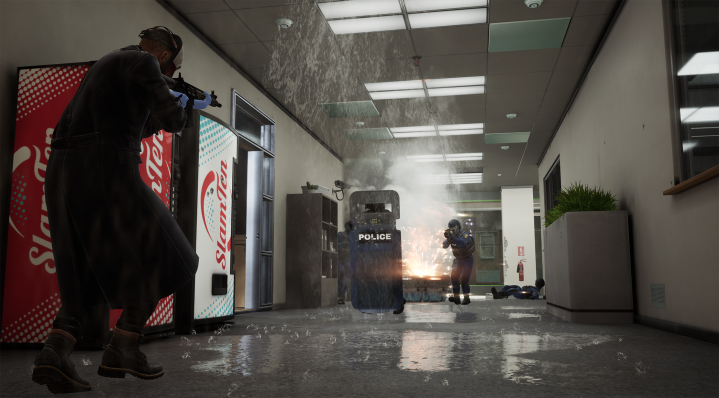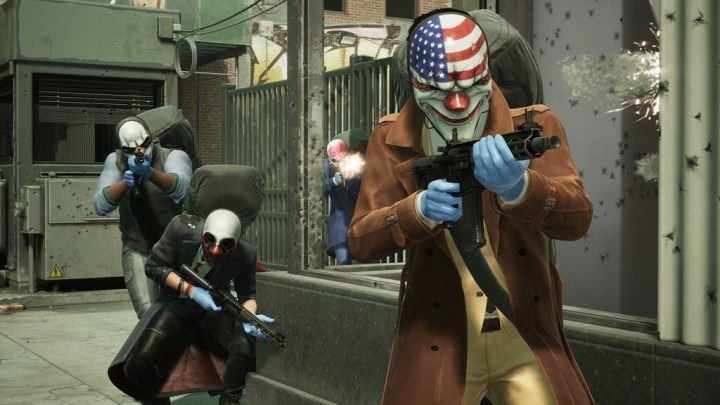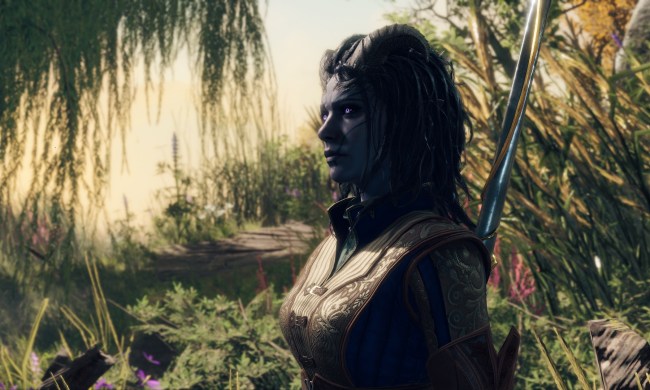How do you follow up a game that’s been running for 10 years? That’s a tricky plan that the developers at Starbreeze Studios would have to create and execute with Payday 3.
Launching on September 21, Payday 3 will have the tough task of following up its incredibly successful predecessor Payday 2, a bank-robbing multiplayer classic that’s been a staple on Steam since 2013. With a fresh coat of paint and a move to the more flexible Unreal Engine, it may sound like Starbreeze is poised to pull off the perfect crime. But as with any heist, it’s never as easy as it sounds on paper. There’s a world of difference between 2013 and 2023, especially in the multiplayer landscape. It’s a far more competitive scene; even games by the biggest studios in the world find themselves shutting down within a year. If Starbreeze was going to get its bag, it would need an ironclad plan — and it has one.
I got an inside look at Payday 3 ahead of its launch, trying out two heists in the upcoming PVE game. While it may not feel too different than Payday 2, Starbreeze’s experience crafting and supporting a 10-year juggernaut shows in what’s shaping up to be a more polished heist sequel. Pulling that off wasn’t just a matter of doubling down on what worked, though. For Starbreeze, it was just as much about learning from Payday 2’s mistakes.
Ocean’s Eleven
After a theatrical introduction to Payday 3’s in-person media event where I became an accessory to a live bank robbery, I was in the right mindset to carry out some digital heists. Despite not having played Payday 2 in years, I quickly became reacquainted with the basics as I put together a loadout. After customizing a few weapons and choosing perks from a massive list of skills, I was ready to make some cold hard cash.
My first attempt didn’t exactly go smoothly. My crew would dive into a new heist called 99 Boxes, which would have us sneaking into a guarded facility and trying to steal money out of storage containers. When a teammate immediately alerted a guard to our presence within 30 seconds, we had to go in loud. Doing so quickly gave me a feel for Payday 3’s snappy gunplay as I mowed down waves of cops. In between those firefights, we’d have to use some navigation wits to find our loot-loaded storage container using any intel we could gather. Once we found it, two of my teammates would grab a bag of thermite and bring it back to burn the lock off — all while fending off the fuzz.

If you’ve played a Payday game before, that kind of Hollywood action set piece probably sounds familiar. Teamwork was key as we’d cover each other’s backs in a maze of storage containers, buying us more time as the lock slowly burned. Once we got our cash, it all ended with a tense run back to our getaway car — a bloody escape plan that only three of us would survive.
We’d get a more classic Payday experience in our second heist, where we’d have to break into a New York City bank and extract duffle bags full of cash. Here, we’d get to try a quieter approach as we started by casing the joint to study its guards and security camera placements. Our first attempt would start well enough, as we’d sneak up to the roof and quietly take out some guards to break in. When we were finally spotted, we had no choice but to take some hostages while we burned a hole into the bank’s vault from the floor above it.
My crew would return to that mission a few times during our session, trying to perfect our plan with each attempt. By our last one, we figured out where we’d need to go to shut down the security system, as well as find a few more handy entrances that we could break into unnoticed. Payday 3’s missions beg to be replayed, pulling some immersive sim levers that call games like Hitman to mind. The heists here are meant to be mastered, rewarding teams who can plot and execute an Ocean’s Eleven-style plan.
Learning from mistakes
That iterative gameplay loop is a fitting metaphor for Payday 3’s actual development. In an interview with Digital Trends at the event, Payday Global Brand Director Almir Listo was transparent in explaining how Strabreeze architected the sequel. It would have a few key advantages this time around, building off the 10-year success of Payday 2. Listo notes that the team is much more prepared to create a long-running game this time, especially thanks to a sturdier foundation in Unreal Engine 4.
The current plan is for Starbreeze to once again create a shooter it can support for 10 years. To do that, it’ll move its focus away from brand collaborations initially and deliver “proper post-launch” updates. That includes its upcoming Year of the Bad Apple update, which will bring four missions and a planned move to Unreal Engine 5. Listo notes that the carefully planned roadmap is a sign that Starbreeze is more prepared this time around and won’t find itself struggling to make content as it’s surprised by its own success as it was in 2013.

That self-reflection was crucial to Payday 3’s development. In speaking about what the team learned over the past decade, Listo emphasizes that the team’s mistakes guided the sequel just as much as its successes.
“In our industry, one of the key things developers tend not to do well is own up to our mistakes,” Listo tells Digital Trends. “You try to shove it under the rug. You need to treat your relationship with the community and players in the same vein you would a significant other: with truth, with respect, and with ambition that over time you can resolve anything together so long as you can build on that mutual relationship.”
When reflecting on what the team learned from Payday 2, Listo cites two specific incidents that shaped the future of the series. Speaking about what he calls the “microtransaction scandal of 2015,” Listo explains the backlash that occurred after Strabreeze went back on its promise to never bring additional monetization to the shooter. The studio took that blowback to heart, learning more about its players’ values in the process.
“I said at the time of launch that we were never going to do this. Shame on you if you think otherwise! And then we did it!” Listo says. “The other thing that we learned is that even though it’s a PVE game, people will still be really mad if you can pay to boost your character. Even if we play on the same team, you want the same rules to apply to you as they do to me. We gamers have a very strong moral compass that we abide by when we play video games. And I think you really need to respect that and live up to that.”
It hurt our reputation and that’s something we’re looking to recover from with Payday 3.
That isn’t the only regret that Starbreeze has taken to heart over the years. Listo also cites the team’s decision to kill console support as another mistake that had to be rectified for Payday 3.
“Having one community is a huge thing,” Listo says. “We stopped support for Payday 2 on consoles way back when. I think that hurt us tremendously. It hurt our reputation and that’s something we’re looking to recover from with Payday 3. Showing the console community that we do care, we do respect you equally with PC players. With Payday 3, it’s going to be one community no matter what platform you play on.”
Listening to the community
Throughout our conversation, community was a recurring theme for Listo. He made it clear that fan feedback shaped Payday 2 and had a direct impact on its sequel’s development. When I asked him just how important community is to the Payday series, he recalled a surprising anecdote, in which an entire questline sprouted from an offhand fan comment.
“When we released Payday: The Heist, we had four characters: Dallas, Hoxton, Wolf, Chains,” Listo says. “But for Payday 2’s launch, we had removed Hoxton and added Houston, Dallas’ younger brother featuring Hoxton’s mask. The community was furious about that at launch. Where the frick is Hoxton, my favorite English boy!? And one dude on Reddit said ‘Maybe’s in jail.’ And we read that comment and said ‘… yeah, he’s in jail!’”

Starbreeze would go on to create an entire suite of content based around that idea, retroactively confirming that Hoxton was indeed in jail all along and sending players on a mission to bust him out. It’s a story that perhaps best encapsulates why Payday 2 has remained a consistent multiplayer hit while so many others have failed. Starbreeze understands the importance of listening to its community and reacting to it. It knows when to be flexible and deliver meaningful content its fans will care about.
While I had fun playing a few rounds of Payday 3, it’s my conversation with Listo that actually leaves me interested in the shooter’s future. I get the sense that Starbreeze has cracked the secret to live service success like a well-locked vault. The studio knows when it’s time to listen to its players, own up to its mistakes, and make the changes its dedicated community deserves. If it can continue to do that with Payday 3, a multiplayer shooter with a more modern backbone, I imagine there’s a lot of gold in Strabreeze’s future.
Payday 3 launches on September 21 for Xbox Series X/S, PS5, and PC.



